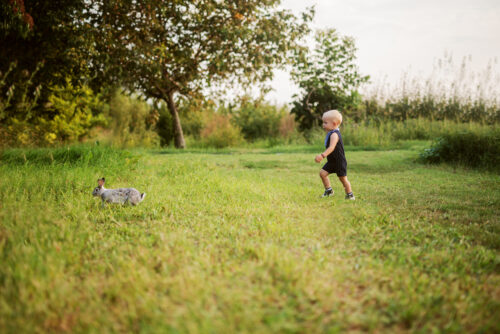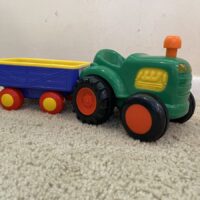Many experts recommend that you wait until age 8 or older before you consider letting your child play outside unsupervised. However, depending on certain decision-making factors, you may choose to let your child play outside alone earlier or later. Here are some good guidelines that can help you determine the best age for your own child to play outdoors alone.
Is Your Child Ready to Be Unsupervised?
If you’ve ever interacted with other children that are different ages than your own, you know that the same age does not equal the same maturity level! Some kids are responsible and ready to be unsupervised at age 8, while others could be ready as early as age 5 or as late as age 10.
One way to gauge whether you can safely leave your child outside is to see how they do inside first. Can you trust your child to play nicely and carefully in a room by themselves? Or do they find trouble?
Here are some essential skills that your kid should have before they can be left alone for long periods of time:
- Showing responsibility with things like chores, homework, and house rules
- Handles unexpected situations by remaining calm
- Understanding and following rules
- Understanding and following safety measures
- Using good judgment
- Basic first aid skills
- How to avoid interaction with strangers
- How to call 911 in the case of emergency
Once your kiddo has mastered these skills and you are ready, try leaving them unsupervised in baby steps. Pick a day when you are around and you can loosely supervise. Check on them every few minutes or peek at them from a window. Make the time between check-ins longer and longer until they have a decent amount of unsupervised playtime.
You’ll likely find that as they play outside unsupervised more often, they’ll get used to it and they’ll get better at it.
Your Child’s Personality
Responsibility differs with various personalities. Some children are submissive and stick close to mamma, others are rebellious and run off the first chance they get!
It’s a no-brainer: responsible, submissive kids will do better unsupervised. You can often let these children have alone time at a younger age, and they might be ready to play outside alone around age 5 or 6. They’ll likely come approach you with problems or just to make sure you are still around, and they’ll also require fewer, less often check-ins from you.
Curious and energetic kids will find trouble because they know how to look for it. Children with a less submissive personality might not be ready to play outside unsupervised until the latter end of the recommended age spectrum, around age 9 or 10. You’ll want to check in on them more often and teach them to come to you with a major problem (e.g. there’s a hole in the fence and the dog got out) versus trying to figure it out themselves (e.g. chasing the dog around the neighborhood on their own).
Where You Live
Are you a city person or a country dweller? Do you have neighbors nearby? Are you near a busy roadway, a school, or another big landmark? Location is something that is often overlooked when people look for guidance concerning an appropriate age for children to play alone outside.
The rules for someone who lives on acreage with no close neighbors will be very different from the rules for someone in a busy downtown apartment. As parental intuition would suggest, if you live in an urban area, it’s probably best to wait to let your child play alone in an outdoor public space. Even then, make sure that it is a safe spot for them to play.
For example, the Power of Play report by the AAP stated that
“Many children do not have safe places to play. Neighborhood threats, such as violence, guns, drugs, and traffic, pose safety concerns in many neighborhoods, particularly low-income areas. . . . Parents who feel that their neighborhoods are unsafe may also not permit their children to play outdoors or independently.”
Outdoor Play Area
Whether you live urban or suburban, if you have your own yard with an appropriate and secure privacy fence, you have a bit more leeway with letting your child outdoors alone. Having a fence and a place to play near the house eliminates the danger of others interfering with your child as they play.
Beyond keeping unwanted people or animals away, a fence will make sure that your child can’t run off. Some kids are runners, others just aren’t. I’m blessed with one child that will wander a safe distance, one child that is stuck to me like velcro, and one that will just run anywhere, at any time, for any (or no) reason. It’s kids like my third that need a fence, or they can’t go out at all until he’s, like, 16.
Aside from a fenced yard or a contained space of some sort, it’s important that there are no dangerous areas that your child will be unsupervised in. We all have that corner of the yard that’s a little sketchy. Maybe like me, you’ve just moved, so you have a bunch of trash and unwanted items stacked in a corner of your yard. Or maybe you have an old barn on your property that’s riddled with rusty nails and rotting boards. Or maybe you have a yard next to the alleyway and somehow you always find that trash and junk get blown or thrown into your yard.
I’ve been in all 3 places, so I know how tough it can be with young kids wandering around. For younger children, preschool-aged and under, it might be best to have a “you can’t go outside without me” rule until you get the dangerous areas sorted out. As your child gets older, you can teach them about those areas and tell them why they are dangerous. For elementary-aged kids, you can most likely warn them, set rules to stay away from those areas, and call it good.
As always, children respond well to distraction. Remember to make sure that there is a safe kid’s play area. Here are some safe child play area ideas:
- Swingset or playset (only if the child can be trusted with heights!)
- Small slide or monkey bars
- Sandbox
- Paved basketball court or play area
- Bike path with bikes or scooters
- Trampoline with net
One final note on the play area: watch out for water. If you have a pool, please take the proper safety precautions, such as having a tall and sturdy gate surrounding the pool area. Even if you don’t have an actual pool, watch out for kiddie pools, ponds, big puddles, and even buckets or containers of water. Children can drown in just a couple of inches of water, so there’s no such thing as being too safe!
If You Have Multiple Children
With multiple children comes multiple responsibilities.
If you want to know when you can let multiple children play outside unsupervised, then there is one simple guideline: is the oldest child ready to be outside alone AND are they ready to take responsibility for the other kids present?
The eldest sibling at age 8 is probably pretty trustworthy when it comes to watching their 5 and 3-year-old siblings play outside sans parental oversight. A 4-year-old probably isn’t ready to watch their toddler sibling outdoors without a parent nearby.
To keep all children involved safe, be sure that the oldest kid knows that since they are outside unsupervised, they are in charge of the other children, which means they have to watch the other children and keep them safe. Let all children know to seek a parent’s help if something bad happens
Are There Laws Governing Outdoor Play?
Because the world we live in is just so crazy, there are now many rules and laws that affect how we can parent.
Did you know that in some states, letting your child be outside alone, constitutes neglect and can result in loss of custody? Nope, I’m not joking. Where it was entirely normal for us to walk around the neighborhood in our youth, our children are granted no such privileges.
Most states with laws have a minimum age to be left alone that ranges from 8 years old to 14 years old. More recently, after backlash from parents who subscribe to the free-range parenting style, some states have adopted new legislation. This legislation redefines neglect so that kids can (safely) play unsupervised, both outdoors and indoors.
So what are some guidelines to help avoid unwanted legal repercussions as a result of letting your child play outside?
First, don’t let them be outside for what could be deemed an unreasonable amount of time. Playing in the front yard alone for 30 minutes is fine, but 3 hours is a bit much.
Second, don’t ever let your child in a situation that could impact their health, safety, or well-being. Letting your 10-year-old child play unsupervised at the playground at your apartment complex is probably okay. On the other hand, dropping them off at a park they’ve never been to and letting them play alone is probably not.
Expert Insight
Cecilia Matson, an Early Childhood and Parenting Expert and Director of Galoop Children’s Classes in Massachusetts, recently talked with Romper about this very subject. Her advice? Give your child a test run in independent play to see how they handle it. If you suspect that your child is reaching a time when they might be alright outdoors all alone, gradually give them more space in the home.
Matson says: “Sometimes encouraging a child to play independently just means sitting back and letting them play without interruption or interjecting, even if you’re still right there with them. Once you start leaving them to play in another room for a little while, you can just see how long it takes before they call for you. This time frame will often gradually get longer and longer, once they start getting used to self-sufficiency.”
The biggest thing recommended: reach a point where you trust your child to make good choices when left alone. Nearly every expert I consulted in my research said that there is no one age you should wait for; instead, wait for the right maturity level. As Matson put it, you should wait for a time when “you trust the way they play and entertain themselves” before you release them into the wild alone.
Conclusion
Our family recently moved and we have a lot of land for our littles to wander around on. This led me to wonder: what is a good age to let a child play outside alone? We let our kids, ages almost 2 to just-turned 8, play in the backyard together without mom and dad. With that being said, we’ve moved out to the country and have a big dog and a big fence.
Your child is probably ready to play outside unsupervised around age 7 or 8. However, your child may be ready earlier or later. This depends on factors like their personality, how well they do alone, and what the outside play area is like. Remember, consult any local laws to avoid unwanted legal repercussions from leaving your kiddos outside by themselves.







